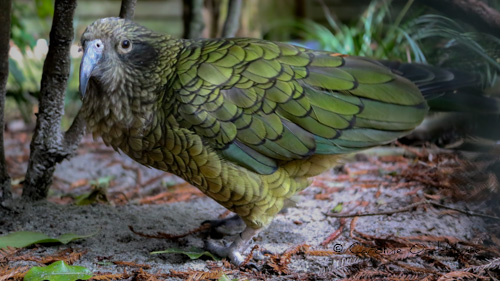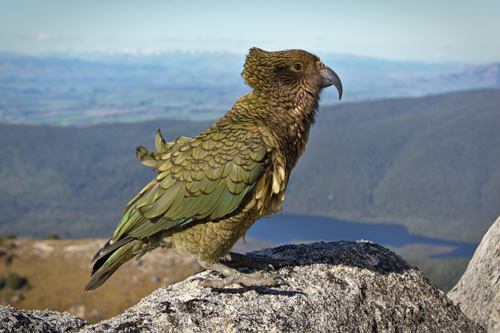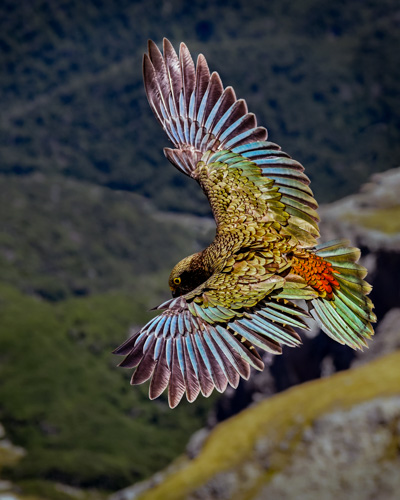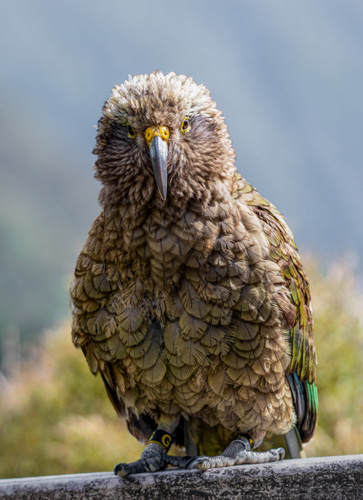Kea Bird of New Zealand: The Only Alpine Parrot in the World
Nestled amidst the pristine landscapes of New Zealand's South Island, the Kea bird (Nestor notabilis) stands out as a true marvel of nature. This unique and highly intelligent parrot species, often referred to as the "clown of the mountains," has captivated the hearts of both locals and tourists for generations.

Kea Bird of New Zealand / Nestor notabilis
In this article, we delve into the world of the New Zealand Kea bird, exploring its fascinating characteristics, its role in the ecosystem, and the challenges it faces in the modern world.
Name, Species Name, and Family
Name: Kea / Scientific Name: Nestor notabilis / Family: Strigopidae
Status: NationallyeEndangered with a population of between 3 and 7 thousand birds.
Other Names for the Kea Bird of New Zealand (Nestor notabilis)
The Kea (Nestor notabilis) is primarily known by its common name, but it's sometimes referred to by other names or nicknames, including:
- Alpine Parrot: This name reflects the Kea's unique habitat, as it's the world's only alpine parrot.
- Mountain Parrot / New Zealand Mountain Parrot: Similar to "Alpine Parrot," these names highlight the Kea's preference for high-altitude mountainous regions.
- Clown of the Mountains: This playful nickname underscores the bird's mischievous and curious nature.
- Kea Parrot: A combination of its common name and its classification as a parrot.
- New Zealand Kea: Emphasizes the bird's native country, distinguishing it from other Kea species found elsewhere.
These various names offer different perspectives on the Kea's identity and characteristics, from its habitat to its personality traits and classification.

Kea Alpine Parrot in Fiordland, South Island, New Zealand. Image by Tomas Sobek
Kea Alpine Parrot: A Feathery Enigma
The Kea is a large, olive-green parrot with striking crimson under-wings, a vibrant orange colouration on the undersides of its wings, and a curious gaze that hints at its high intelligence. It inhabits the alpine regions of New Zealand's South Island, where it thrives in the challenging environment of rugged mountains and dense forests.
The Kea's adaptability to such harsh conditions is nothing short of remarkable, considering it's the world's only alpine parrot.
Kea Bird Intelligence Unleashed
One of the most captivating aspects of the Kea bird of New Zealand is its exceptional intelligence. Researchers have long been amazed by the Kea's problem-solving abilities, which are on par with some primates. The Kea's intelligence is particularly evident in its foraging techniques.
Mischievous Parrots
These alpine birds are notorious for exploring human-made objects, often to the detriment of tourists and locals alike. They have been known to dismantle cars, chew on tyres, and even steal items from hikers and campers.
You may interested in other wildlife...
List of native New Zealand birds and other wildlife in New Zealand
Problem Solvers
Their natural inquisitiveness and problem-solving skills have made the Kea a subject of intense scientific study. Researchers have devised puzzles and challenges to understand the depths of their cognitive abilities. These studies have revealed that Kea parrots can demonstrate a keen understanding of cause and effect, tool use, and even cooperation. Their playful and curious nature has endeared them to scientists and bird enthusiasts worldwide.

Kea Bird Flying in Arthur's Pass Southern Alps, South Island. Image by Karl Anderson
New Zealand Kea are Social Creatures
Social Lives and Communication
Kea are highly social birds and form strong bonds within their communities. They are often seen in groups, engaging in activities like aerial acrobatics and vocalizing with loud, eerie calls that echo through the mountains. These vocalisations play a crucial role in Kea society, helping them communicate with one another across the vast alpine landscapes.
Breeding
The social nature of these birds extends to their mating habits. Keas typically form monogamous pairs during the breeding season, which runs from July to January. These pairs work together to build nests, incubate eggs, and care for their young. The parenting skills exhibited by Kea couples are yet another testament to their intelligence and cooperative nature.
Kea Bird’s Role in the New Zealand Ecosystem
Despite their playful antics and occasional mischievous behaviour, Keas play an essential role in New Zealand's delicate alpine ecosystem.
Kea Diet
They primarily feed on a diet of plant material, insects, and carrion, helping to control insect populations and contributing to nutrient recycling in their habitats.
Plant Seed Dispersal
Additionally, Keas are vital to the ecosystem as seed dispersers. They consume a variety of seeds and then spread them throughout their range, aiding in the regeneration of native plant species. This, in turn, benefits other wildlife by providing a stable food source.
Conservation Challenges for Alpine Kea Parrot Survival
While Keas have thrived in their alpine homes for thousands of years, they face significant challenges in the modern world. The introduction of non-native predators such as stoats, possums, and rats has posed a severe threat to Kea populations, particularly during their vulnerable nesting phase. These predators can decimate Kea nests, reducing their reproductive success.
Human activities have also impacted Keas. Habitat destruction, hunting, and accidental poisoning from pest control measures have all taken a toll on these birds. Conservation efforts have been put in place to mitigate these threats, including the establishment of protected areas and ongoing pest control programs.
You may be interested in visiting the Kea Conservation Trust for more information.
Tourism and the Kea Bird of New Zealand
Keas have become a beloved icon of New Zealand's wildlife, attracting tourists from around the world. Their charismatic personalities and unique behaviours make them a sought-after sight for travellers exploring the country's stunning landscapes. However, the very tourism that brings attention to these birds also poses a challenge. Feeding Keas human food, as some tourists are tempted to do, can have harmful consequences for Kea health.

Kea Sitting on a Fence Expecting Food. Image by John Yunker
Feeding Keas with anything at all can lead to malnutrition and a reliance on handouts, disrupting their natural foraging behaviours. Additionally, some foods, like chocolate and processed snacks, are toxic to Keas. Responsible tourism practices, such as refraining from feeding wild Keas and observing them from a respectful distance, are essential to protect these birds and their natural behaviours.
Where You Can See Kea Birds
South Island alpine and forested regions in New Zealand. This country is the only place in the world where you can see Kea Alpine Parrots. The Kea is the only parrot in the world that lives in mountain regions.
West Coast region, near to the glaciers
On the way to Milford Sound you may catch site of Kea around the Monkey Creek or Homer Tunnel areas.
Conclusion and the Future for New Zealand Kea Parrots
The Kea bird of New Zealand is a captivating blend of intelligence, playfulness, and adaptability. Their presence in the alpine regions of the South Island adds to the rich tapestry of New Zealand's unique biodiversity. While they face challenges in the form of introduced predators and human activities, dedicated conservation efforts and responsible tourism practices offer hope for their continued survival.
As we continue to learn more about these mischievous marvels of the avian world, it becomes increasingly clear that the Kea bird species deserves our admiration, respect, and protection. Their resilience in the face of adversity serves as a reminder of the importance of preserving the natural world and the incredible creatures that call it home. So, the next time you find yourself amidst the breathtaking landscapes of New Zealand's South Island, keep an eye out for the Kea and appreciate the beauty of this feathered enigma that graces the high alpine realms.